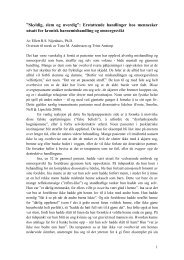rapport 2015:4
641aa6d88d
641aa6d88d
You also want an ePaper? Increase the reach of your titles
YUMPU automatically turns print PDFs into web optimized ePapers that Google loves.
130. von Sydow, K., Retzlaff, R., Beher, S., Haun, M.W.,<br />
Schweitzer, J. (2013). The efficacy of systemic<br />
therapy for childhood and adolescent externalizing<br />
disorders: A systematic review of 47 RCT. Family<br />
Process. 52(4): p. 576-618.<br />
131. Stratton, P., Silver, E., Naschimento, N., McDonnell.<br />
L., Powell, G., Nowotny, E. (<strong>2015</strong>). Couple and<br />
family therapy outcome research in the previous<br />
decade: what does the evidence tell us?. Contemporary<br />
Family Therapy. 37: p. 1-12.<br />
132. Minuchin, S. and H.C. Fishman (1981). Family<br />
Therapy Techniques. Cambridge, UK: Harvard<br />
University Press.<br />
133. Minuchin, S. (1974). Families and Family Therapy.<br />
Cambridge: Harvard University Press.<br />
134. Redaktørens kommentar (1999). Barn og familieterapi:<br />
“You must learn to talk to children”, Salvador<br />
Minuchin. Fokus på familien. 4: p. 201-202.<br />
135. Lilledalen, G. (1984). En presentasjon av strukturell<br />
familieterapi. Fokus på familien. 2: p. 3-20.<br />
136. Selvini Palazzoli, M., et al. (1980). Hypothesizing<br />
- circularity - neutrality: Three guidelines for the<br />
conductor of the session. Family Process. 19: p.<br />
3-12.<br />
137. Selvini Palazzoli, M., et al. (1974). The treatment<br />
of children through brief therapy of their parents.<br />
Family Process. 13: p. 429-442.<br />
138. Anderson, H. and H. Goolishian (1988). Human<br />
systems as linguistic systems: preliminary and<br />
evolving ideas about the implications for clinical<br />
theory. Family Process. 27: p. 371-393.<br />
139. Anderson, H. and H. Goolishian (1992). The client<br />
is the expert: A not-knowing approach to therapy in<br />
Therapy as Social Construction, S. MacNamee and<br />
K. Gergen, Editors, SAGE Publications: London.<br />
140. Andersen, T. (1987). The reflecting team: Dialogue<br />
and meta-dialogue in clinical work. Family Process.<br />
26(4): p. 415-428.<br />
141. Førland, M.D. (1993). Goolishian sett gjennom<br />
barnebriller. Fokus på familien. 1: p. 15-37.<br />
142. White, M. and D. Epston (1990). Narrative<br />
Means to Therapeutic Ends. N.Y.: W.W. Norton &<br />
Company.<br />
143. White, M. (1984). Pseudo-encopresis: from<br />
avalanche to victory, from vicious to virtuous cycles.<br />
Family Systems Medicine. 2: p. 150 - 160.<br />
144. Freeman, J., D. Epston, and D. Lobovits (1997).<br />
Playful Approaches to Serious Problems. Narrative<br />
Therapy with Children and Their families. N.Y.: W.W.<br />
Norton & Company.<br />
145. Silver, E., et al. (1998). Family therapy and soiling:<br />
an audit of externalizing and other approaches.<br />
Journal of Family Therapy. 20: p. 413- 422.<br />
146. Besa, D., (1994). Evaluating narrative family<br />
therapy using single-system research design. Research<br />
on Social Work Practice. 4(3).<br />
147. Australian Government (1998). Child inclusive<br />
practice in family and child counselling and family<br />
and child mediation. Department of Social<br />
Services, Families and Children. Tilgjengelig fra:<br />
https://www.dss.gov.au/our-responsibilities/<br />
families-and-children/publications-articles/childinclusive-practice-in-family-and-child-counselling-and-family-and-child-mediation-0?HTML.<br />
148. Lebow, J. (2003). Integrative family therapy for<br />
disputes involving child custody and visitation.<br />
Journal of Family Psychology. 17(2): p. 181-192.<br />
149. Lebow, J. and K.N. Rekart (2007). Integrative<br />
family therapy for high-conflict divorce with<br />
disputes over child custody and visitation. Family<br />
Process. 46(1): p. 79-91.<br />
150. Kolko, D.J. (<strong>2015</strong>). Alternatives for Families – A<br />
Cognitive Behavior Therapy. Tilgjengelig fra:<br />
http://www.afcbt.org/.<br />
151. Kolko, D. and C.C. Swenson (2002). Assessing and<br />
Treating Physically Abused Children and Their Families<br />
London: Sage Publications Inc.<br />
152. Kolko, D.J. (1996). Individual cognitive-behavioral<br />
treatment and family therapy for physically abused<br />
children and their offending parents: A comparison<br />
of clinical outcomes. Child Maltreatment. 1: p.<br />
322-342.<br />
153. Kolko, D.J., Iselin, A. M., Gully, K. (2011). Evaluation<br />
of the sustainability and clinical outcome of<br />
Alternatives for Families: A Cognitive-Behavioral<br />
Therapy (AF-CBT) in a child protection center. Child<br />
Abuse & Neglect. 35: p. 105-116.<br />
98<br />
Rapport <strong>2015</strong>:4 • Folkehelseinstituttet



